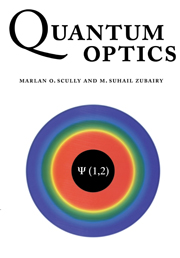Book contents
- Frontmatter
- Contents
- Dedication
- Preface
- 1 Quantum theory of radiation
- 2 Coherent and squeezed states of the radiation field
- 3 Quantum distribution theory and partially coherent radiation
- 4 Field–field and photon–photon interferometry
- 5 Atom–field interaction – semiclassical theory
- 6 Atom–field interaction – quantum theory
- 7 Lasing without inversion and other effects of atomic coherence and interference
- 8 Quantum theory of damping – density operator and wave function approach
- 9 Quantum theory of damping – Heisenberg–Langevin approach
- 10 Resonance fluorescence
- 11 Quantum theory of the laser – density operator approach
- 12 Quantum theory of the laser – Heisenberg–Langevin approach
- 13 Theory of the micromaser
- 14 Correlated emission laser: concept, theory, and analysis
- 15 Phase sensitivity in quantum optical systems: applications
- 16 Squeezing via nonlinear optical processes
- 17 Atom optics
- 18 The EPR paradox, hidden variables, and Bell's theorem
- 19 Quantum nondemolition measurements
- 20 Quantum optical tests of complementarity
- 21 Two-photon interferometry, the quantum measurement problem, and more
- Index
13 - Theory of the micromaser
Published online by Cambridge University Press: 05 June 2012
- Frontmatter
- Contents
- Dedication
- Preface
- 1 Quantum theory of radiation
- 2 Coherent and squeezed states of the radiation field
- 3 Quantum distribution theory and partially coherent radiation
- 4 Field–field and photon–photon interferometry
- 5 Atom–field interaction – semiclassical theory
- 6 Atom–field interaction – quantum theory
- 7 Lasing without inversion and other effects of atomic coherence and interference
- 8 Quantum theory of damping – density operator and wave function approach
- 9 Quantum theory of damping – Heisenberg–Langevin approach
- 10 Resonance fluorescence
- 11 Quantum theory of the laser – density operator approach
- 12 Quantum theory of the laser – Heisenberg–Langevin approach
- 13 Theory of the micromaser
- 14 Correlated emission laser: concept, theory, and analysis
- 15 Phase sensitivity in quantum optical systems: applications
- 16 Squeezing via nonlinear optical processes
- 17 Atom optics
- 18 The EPR paradox, hidden variables, and Bell's theorem
- 19 Quantum nondemolition measurements
- 20 Quantum optical tests of complementarity
- 21 Two-photon interferometry, the quantum measurement problem, and more
- Index
Summary
The development of a single-atom maser or a micromaser allows a detailed study of the atom–field interaction. The situation realized is very close to the ideal case of a single two-level atom interacting with a single-mode quantized field as treated in Section 6.2. In a micromaser a stream of two-level atoms is injected into a superconducting cavity with a high quality factor. The injection rate can be such that only one atom is present inside the resonator at any time. Due to the high quality factor of the cavity, the radiation decay time is much larger than the characteristic time of the atom–field interaction, which is given by the inverse of the single-photon Rabi frequency. Therefore, a field is built up inside the cavity when the mean time between the atoms injected into the cavity is shorter than the cavity decay time. A micromaser, therefore, allows sustained oscillations with less than one atom on the average in the cavity.
The realization of a single-atom maser or a micromaser has been made possible due to the enormous progress in the construction of superconducting cavities together with the laser preparation of highly excited atoms called Rydberg atoms. The quality factor of the superconducting cavities is high enough for periodic energy exchanges between atom and cavity field to be observed. The interesting properties of the Rydberg atoms make them ideal for micromasers. In Rydberg atoms the probability of induced transitions between adjacent states becomes very large and scales as n4, where n denotes the principle quantum number.
- Type
- Chapter
- Information
- Quantum Optics , pp. 383 - 401Publisher: Cambridge University PressPrint publication year: 1997



